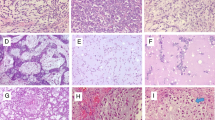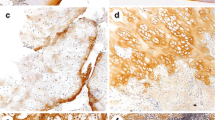Abstract
Distinguishing osteochondroma from low-grade secondary peripheral chondrosarcoma can be difficult. In osteochondroma, growth-signalling pathways are thought to be downregulated through exostosin (EXT) inactivation. A previous pilot study focusing on expression of putative EXT downstream effectors indicated that progression of osteochondroma towards grade I chondrosarcoma was characterised by upregulation of Bcl-2 and parathyroid hormone-like hormone (PTHLH). We investigated their use as diagnostic markers in a large nationwide series of 71 osteochondromas and 34 chondrosarcomas. Bcl-2 immunohistochemistry proved to be a valuable diagnostic tool: scoring negative in 95% (specificity) of the osteochondromas and positive in 57% (sensitivity) of the chondrosarcomas, reaching a positive predictive value of 84% and negative predictive value of 82%. Positivity was not related to age, hereditary status, gender or thickness of the cartilage cap. Presence of internal controls and verification using mRNA in situ hybridisation strengthened the reliability of the immunohistochemical staining. PTHLH showed more variable staining, being positive in osteochondromas from females or adolescent males, suggesting age- and gender-dependent expression. Thus, in cases where the distinction between osteochondroma and chondrosarcoma is difficult, Bcl-2 is a valuable diagnostic marker for malignancy, regardless of tumour size, patient gender or age, and this can be extended with PTHLH for non-adolescent male patients.




Similar content being viewed by others
References
Ahn J, Ludecke H-J, Lindow S, Horton WA, Lee B, Wagner MJ, Horsthemke B, Wells DE (1995) Cloning of the putative tumour suppressor gene for hereditary multiple exostoses (EXT1). Nat Genet 11:137–143
Amling M, Neff L, Tanaka S, Inoue D, Kuida K, Weir E, Philbrick WM, Broadus AE, Baron R (1997) Bcl-2 lies downstream of parathyroid hormone related peptide in a signalling pathway that regulates chondrocyte maturation during skeletal development. J Cell Biol 136:205–213
Amling M, Posl M, Hentz MW, Priemel M, Delling G (1998) PTHrP and Bcl-2: essential regulatory molecules in chondrocyte differentiation and chondrogenic tumors. Verh Dtsch Ges Pathol 82:160–169
Bertoni F, Bacchini P, Hogendoorn PCW (2002) Chondrosarcoma. In: Fletcher CDM, Unni KK, Mertens F (eds) World Health Organisation classification of tumours. Pathology and genetics of tumours of soft tissue and bone. IARC Press, Lyon
Bland R (2000) Steroid hormone receptor expression and action in bone. Clin Sci (Lond) 98:217–240
Bovée JVMG, Cleton-Jansen AM, Kuipers-Dijkshoorn N, Van den Broek LJCM, Taminiau AHM, Cornelisse CJ, Hogendoorn PCW (1999) Loss of heterozygosity and DNA ploidy point to a diverging genetic mechanism in the origin of peripheral and central chondrosarcoma. Genes Chromosomes Cancer 26:237–246
Bovée JVMG, Cleton-Jansen AM, Wuyts W, Caethoven G, Taminiau AHM, Bakker E, Van Hul W, Cornelisse CJ, Hogendoorn PCW (1999) EXT-mutation analysis and loss of heterozygosity in sporadic and hereditary osteochondromas and secondary chondrosarcomas. Am J Hum Genet 65:689–698
Bovée JVMG, Hogendoorn PCW (2002) Multiple osteochondromas. In: Fletcher CDM, Unni KK, Mertens F (eds) World Health Organization classification of tumours. Pathology and genetics. Tumours of soft tissue and bone. IARC Press, Lyon
Bovée JVMG, Van den Broek LJCM, Cleton-Jansen AM, Hogendoorn PCW (2000) Up-regulation of PTHrP and Bcl-2 expression characterizes the progression of osteochondroma towards peripheral chondrosarcoma and is a late event in central chondrosarcoma. Lab Invest 80:1925–1933
Bovée JVMG, Van den Broek LJCM, De Boer WI, Hogendoorn PCW (1998) Expression of growth factors and their receptors in adamantinoma of long bones and the implications for its histogenesis. J Pathol 184:24–30
De Boer WI, van Schadewijk A, Sont JK, Sharma HS, Stolk J, Hiemstra PS, van Krieken JH (1998) Transforming growth factor beta1 and recruitment of macrophages and mast cells in airways in chronic obstructive pulmonary disease. Am J Respir Crit Care Med 158:1951–1957
Eilers PHC, Marx BD (1996) Flexible smoothing with B-splines and penalties. Stat Sci 11:89–102
Elkhuizen PHM, Voogd AC, Van den Broek LJCM, Tan ITC, Van Houwelingen HC, Leer J-WH, Van de Vijver MJ (1999) Risk factors for local recurrence after breast-conserving therapy for invasive carcinomas: a case-control study of histological factors and alterations in oncogene expression. Int J Radiat Oncol Biol Phys 45:73–83
Evans HL, Ayala AG, Romsdahl MM (1977) Prognostic factors in chondrosarcoma of bone. A clinicopathologic analysis with emphasis on histologic grading. Cancer 40:818–831
Geirnaerdt MJ, Hogendoorn PCW, Bloem JL, Taminiau AHM, Van der Woude HJ (2000) Cartilaginous tumors: fast contrast-enhanced MR imaging. Radiology 214:539–546
Gomez J, Martinez A, Gonzalez A, Garcia A, Rebollo A (1998) The Bcl-2 gene is differentially regulated by IL-2 and IL-4: role of the transcription factor NF-AT. Oncogene 17:1235–1243
Grimsrud CD, Romano PR, D’Souza M, Puzas JE, Reynolds PR, Rosier RN, O’Keefe RJ (1999) BMP-6 is an autocrine stimulator of chondrocyte differentiation. J Bone Miner Res 14:475–482
Gurova KV, Gudkov AV (2003) Paradoxical role of apoptosis in tumor progression. J Cell Biochem 88:128–137
Khurana J, Abdul-Karim F, Bovée JVMG (2002) Osteochondroma. In: Fletcher CDM, Unni KK, Mertens F (eds) World Health Organization classification of tumours. Pathology and genetics. Tumours of soft tissue and bone. IARC Press, Lyon
Kunisada T, Moseley JM, Slavin JL, Martin TJ, Choong PF (2002) Co-expression of parathyroid hormone-related protein (PTHrP) and PTH/PTHrP receptor in cartilaginous tumours: a marker for malignancy? Pathology 34:133–137
Lanske B, Karaplis AC, Lee K, Luz A, Vortkamp A, Pirro A, Karperien M, Defize LHK, Ho C, Mulligan RC, Abou-Samra A-B, Juppner H, Segre GV, Kronenberg HM (1996) PTH/PTHrP receptor in early development and Indian hedgehog-regulated bone growth. Science 273:663–666
Lindsey JK, Jones B (1998) Choosing among generalized linear models applied to medical data. Stat Med 17:59–68
Martin B, Paesmans M, Berghmans T, Branle F, Ghisdal L, Mascaux C, Meert AP, Steels E, Vallot F, Verdebout JM, Lafitte JJ, Sculier JP (2003) Role of Bcl-2 as a prognostic factor for survival in lung cancer: a systematic review of the literature with meta-analysis. Br J Cancer 89:55–64
Mirra JM, Gold R, Downs J, Eckardt JJ (1985) A new histologic approach to the differentiation of enchondroma and chondrosarcoma of the bones. A clinicopathologic analysis of 51 cases. Clin Orthop 201:214–237
Mulder JD (ed) (1993) Radiologic atlas of bone tumors. Elsevier, Amsterdam
Paspaliaris V, Petersen DN, Thiede MA (1995) Steroid regulation of parathyroid hormone-related protein expression and action in the rat uterus. J Steroid Biochem Mol Biol 53:259–265
Pateder DB, Gish MW, O’Keefe RJ, Hicks DG, Teot LA, Rosier RN (2002) Parathyroid hormone-related Peptide expression in cartilaginous tumors. Clin Orthop 198–204
Simmons AD, Musy MM, Lopes CS, Hwang L-Y, Yang Y-P, Lovett M (1999) A direct interaction between EXT proteins and glycosyltransferases is defective in hereditary multiple exostoses. Hum Mol Genet 8:2155–2164
Stickens D, Clines G, Burbee D, Ramos P, Thomas S, Hogue D, Hecht JT, Lovett M, Evans GA (1996) The EXT2 multiple exostoses gene defines a family of putative tumour suppressor genes. Nat Genet 14:25–32
Van der Eerden BCJ, Gevers EF, Lowik CW, Karperien M, Wit JM (2002) Expression of estrogen receptor alpha and beta in the epiphyseal plate of the rat. Bone 30:478–485
Van der Eerden BCJ, Karperien M, Wit JM (2001) The estrogen receptor in the growth plate: implications for pubertal growth. J Pediatr Endocrinol Metab 14(Suppl 6):1527–1533
Van der Eerden BCJ, Karperien M, Gevers EF, Lowik CWGM, Wit JM (2000) Expression of Indian Hedgehog, PTHrP and their receptors in the postnatal growth plate of the rat: evidence for a locally acting growth restraining feedback loop after birth. J Bone Miner Res 15:1045–1055
Wuyts W, Van Hul W, Wauters J, Nemtsova M, Reyniers E, Van Hul E, De Boulle K, De Vries BBA, Hendrickx J, Herrygers I, Bossuyt P, Balemans W, Fransen E, Vits L, Coucke P, Nowak NJ, Shows TB, Mallet L, Van den Ouweland AMW, McGaughran J, Halley DJJ, Willems P (1996) Positional cloning of a gene involved in hereditary multiple exostoses. Hum Mol Genet 5:1547–1557
Acknowledgements
The contribution of the Dutch national pathology database ‘Stichting PALGA’ and the Netherlands Committee of Bone Tumours to this study is thankfully acknowledged. The authors gratefully acknowledge Hans J. Baelde and Ayse Yavas for expert technical assistance, Dr. M. Karperien for fruitful discussions, Klaas G. van der Ham for graphical assistance and the different medical centres that shared their cases with us. This work was financially supported by the Dutch Cancer Society (grant-no. RUL 2002–2738) and was presented in part at the 91st annual meeting of the United States and Canadian Academy of Pathology (USCAP, 2002) and the 15th annual meeting of the European Musculoskeletal Oncology Society (EMSOS, 2002). All investigations were performed according to the national ethics guidelines for the use of patient material.
Author information
Authors and Affiliations
Corresponding author
Rights and permissions
About this article
Cite this article
Hameetman, L., Kok, P., Eilers, P.H.C. et al. The use of Bcl-2 and PTHLH immunohistochemistry in the diagnosis of peripheral chondrosarcoma in a clinicopathological setting. Virchows Arch 446, 430–437 (2005). https://doi.org/10.1007/s00428-005-1208-4
Received:
Accepted:
Published:
Issue Date:
DOI: https://doi.org/10.1007/s00428-005-1208-4




